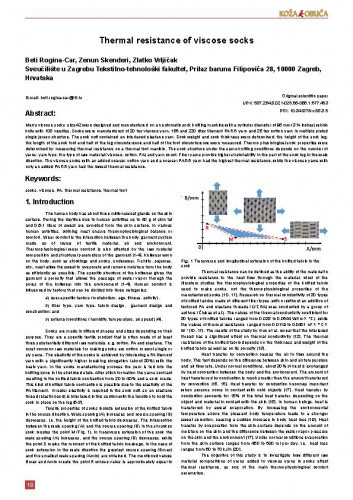Men's viscose socks size 42 were designed and manufactured on an automatic sock knitting machine with a cylinder diameter of 95 mm (3 ¾ inches) which knits with 108 needles. Socks were manufactured of 20 tex viscose yarn, 156 and 220 dtex filament PA 6.6 yarn and 25 tex cotton yarn in multiple plated single jersey structure. The sock cuff contained an interlaced elastane yarn. Sock weight and sock thickness were determined, the height of the sock leg, the length of the sock foot and half of the leg circumference and half of the foot circumference were measured. Thermo physiological sock properties were determined by measuring thermal resistance on a thermal foot manikin. The sock structure under the same knitting conditions depends on the number of yarns, yarn type, the type of raw material (viscose, cotton, PA) and yarn count. Finer yarns provide higher stretchability in the part of the sock leg in the wale direction. The viscose socks with an added coarser cotton yarn and a coarser PA 6.6 yarn had the highest thermal resistance, while the viscose yarns with only an added PA 6.6 yarn had the lowest thermal resistance.
Sažetak

 Koža i obuća : časopis za kožu, obuću, dizajn te srodna područja u interdisciplinarnom pristupu = the journal for leather, footwear, design, as well as other similar areas in an interdisciplinary approach : 68,3(2019) / glavni i odgovorni urednik, editor-in-chief Budimir Mijović.
Koža i obuća : časopis za kožu, obuću, dizajn te srodna područja u interdisciplinarnom pristupu = the journal for leather, footwear, design, as well as other similar areas in an interdisciplinary approach : 68,3(2019) / glavni i odgovorni urednik, editor-in-chief Budimir Mijović.